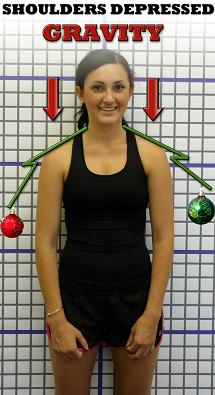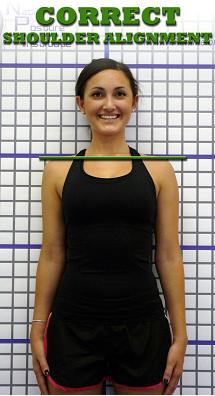Are You Losing the "Fight Against Gravity"?
Have
you ever experienced chronic shoulder/neck pain, spasms, fatigue,
tenderness, or tension headaches after a long exhaustive day of work?
Well if you have, you are not alone because issues in the upper shoulder
region have become increasingly frequent in recent decades. The rise
in neck pain is now second to only back pain in the occurrence of
musculoskeletal disorders. The frequency of symptoms of neck disorders
has caused it to become a major public health problem(1). It is not
surprising due to the increased reliance upon technology, especially the
computer. Many positions within the current national workforce require
long durations in front of the computer causing fatigued posture and
the development of chronic neck pain. Pilates classes have also been a
culprit in contributing to shoulder tension through their ironic
“relaxing” cues for the shoulders. Some examples taken from magazines,
pilates studios and instructors include: “shoulders in your back
pockets” and “Shoulders away from your ears” to name a few (2,3,4).
Whether we are actively depressing our shoulders during pilates class or
are inadvertently facing the consequences of gravity – neck pain has
become an unfortunate frequent complaint in recent decades.
The
source of the symptoms within the upper shoulder and neck region can be
multi-factorial including injuries affecting muscle, tendons, joints,
ligaments, and bones through mechanically overloading the biological
structures(5). Overloading the tissue is common through high intensity
forces or torques acting upon the body such as performing tasks in
regards to lifting, pushing, or pulling objects. Alternatively,
internal forces, such as friction, muscular imbalances, joint pressures
and bony tuberances must be considered. The internal mechanics have not
received much attention until recently due to technical limitations(6).
Despite limitations in research, the importance of internal mechanics
is significant and can be largely controlled through posture and body
alignment and deserves more attention when discussing neck
pain/disorders. Good posture alignment results in the body being in a
state of musculoskeletal balance where weight distribution on the
supporting structures ensures maximal joint stability(7).
Although
neck pain and disorders can stem from a broad range of sources, many
troubles in the upper shoulder region can be traced back to the upper
trapezius muscle. In everyday pursuits the upper trapezius muscle is
constantly working against gravity to maintain scapular positioning.
The lack of kinesthetic awareness (bodily awareness of its position in
space) results in a depressed scapulae (shoulder blades) or slumped
shoulder look. (See Figure A below) I term this the “fight against
gravity”. Unfortunately for many, gravity always wins resulting in a
“Christmas tree” look.
So how is poor posture and the lack of
kinesthetic awareness responsible for issues concerning the upper
trapezius muscle? To understand the issues, one must become
familiarized with the anatomical position as well as functions of the
trapezius muscle (See Table #1 below). A thorough understanding of the
upper trapezius will further illustrate the pronounced occurrence of
issues related to the muscle. When the upper trapezius fibers lose the
“fight against gravity” they experience mechanical stress through
increased intramuscular tissue pressure(8). The increased intramuscular
pressure results from the poor length-tension relationship by the
muscle. With the shoulder slumped and the scapula depressed the upper
trapezius is a lengthened state. To illustrate the effects of the
increased intramuscular pressure experienced by the upper trapezius
muscle practice the demonstration below.
Demonstration 1:
Take
a rubber band and cut the band at some point creating a single strand.
Stand in front of a mirror holding each side of the rubber band with
one hand. Place one hand close to the neckline and the other end over
the acromion process (shoulder) – Imitating the upper trapezius muscle
orientation. Elevate and depress your shoulder while noticing the
altered tension of the rubber band!
Over time, through
constant static contractions of the lengthened upper trapezius, the
muscle is susceptible to force development problems. Other
physiological responses resulting from the high-tension development
include altered blood flow to the muscle reducing oxygen supply and
causing metabolites to accumulate. The physiological responses are
responsible for the fatigue perception within the upper neck region(8).
In summary, when the upper trapezius muscle is in a lengthened state it
causes a cascading effect of muscular deformation through increasing
intramuscular pressure(8), reduced blood supply(9), limited oxygen(9),
and hindered force development(8). The mechanical and physiological
responses cause the perceived fatigue, discomfort, pain, tenderness,
spasms, triggerpoints, weakness, and headaches.
Understanding
the complexity of upper neck/shoulder disorders is crucial to
implementing an approach at eliminating pain and restoring function.
With a multitude of disorders stemming from a mechanical stress overload
of the upper trapezius muscle the focus will be placed upon addressing
the overload.
The National Posture Institute’s 4 Points of Posture Program™
The
four points of posture are simplified mental imagery cues that can be
used to learn and establish a better postural alignment.
1. Stand Tall
a. Visualize the vertebral column lengthening and growing taller
2. Hold Chest/Shoulder High
a. Visualize opening up the chest and creating a geometric 90 angle of the shoulders and leveling out the shoulders
3. Retract Scapulae
a. Visualize holding a pencil between the scapulas (Shoulder blades)
4. Contract Abdominals
a. Visualize drawing the belly button toward the spine and isometrically contracting the core musculature.
Integration
of the four points will position the musculoskeletal system in a more
optimal alignment. Point one standing tall will reduce the compression
upon the vertebral discs. Point two will create symmetry in the
shoulders through creating a geometric 90-degree angle. In order to
create a 90-degree angle (leveling out the shoulders) many will have to
elevate their shoulders resulting in a better length tension
relationship of the upper trapezius muscle tissue. Point three is
abducting the scapulas through retraction that positions the
glenohumeral joint in a more optimal anatomical position. Point three
focuses on minimizing the rounded shoulder posture (abducted
scapula/internal rotation/shoulder pronation). Finally, point four
contracting the abdominals isometrically will neutralize the pelvis and
create the natural curvatures in the spinal column.
Demonstration #2:
In
a normal alignment, take two or three fingers and palpate the upper
trapezius muscle fibers. Assess the tone of the muscle tissue (firm,
pliable, knots, etc.). Implement NPI’s Four Points of Posture and then
re-assess by palpating the upper trapezius. The length-tension
relationship should have created more soft and pliable tone to the
muscle structure!
Implementing the four points prior to
engaging in exercise movements is crucial toward establishing better
postural alignment. Through reinforcement of the points new neural
pathways will be established creating better length tension
relationships amongst tissues. The body will become balanced,
ultimately enhancing functional capacity, and reducing any symptoms
within the upper trapezius and upper shoulder/neck region.
NPI Summary Points
- Your body is always working against gravity - “Fight Against Gravity”
- Slumped Shoulders/Depressed Scapula = Lengthened/Weakened Upper Trapezius
- Develop a kinesthetic sense of the glenohumeral joint
- Implement NPI’s Four Points of Posture to improve alignment
- Establish Better Alignment by Strengthening Weakened Tissues
Table 1: Upper Trapezius Muscle
| Origin |
External Occipital Protuberance, Ligamentum Nuchae, and Spinous Process of the seventh cervical vertebra. |
| Insertion |
Lateral third of the Clavicle and Acromion Process of the Scapula. |
Scapular Movements
|
Elevation, Upward Rotation
|
Bilateral Contraction
|
Cervical (Neck) Extension (Fixed Shoulder Bones) |
| Unilateral Contraction |
Lateral Cervical Flexion or Contralateral Rotation of the head |
Table #1 – Origin, Insertion, and Movements of the Upper Trapezius(10)
Figure A - Integrated 4 Points of Posture, Scapulas/"Christmas Tree" Look
 
REFERENCES
- Fejer R, Kyvik KO, Hartvigsen J: The prevalence of neck pain in the world population: a systematic critical review of the literature. Eur Spine J 2006, 15(6):834-848.
- "Pilates and Posture - Achieving Good Alignment - Pilates for Good Posture." Pilates - Exercises and Equipment for Strength and Flexibility - Pilates DVD Reviews and More. Web. 08 Sept. 2011. <http://pilates.about.com/od/pilatesexercises/a/PilatesPosture.htm>.
- "Pilates Magic Circle: Core Exercises | Women's Health Magazine." Women's Health: Health, Fitness, Weight Loss, Healthy Recipes & Beauty. Web. 08 Sept. 2011. <http://www.womenshealthmag.com/weight-loss/magic-circle>.
- Sommers, Susan. "Keep Your Shoulders Down!" Pilates Instructor New York City 10023, NYC, Pilates over 50. Web. 08 Sept. 2011. <http://www.pilatesbodynyc.com/keep-your-shoulders-down/>.
- "WHO | Data and Statistics." Occupational Health. WHO. Web. 01 Apr. 2011. <http://www.who.int/research/en/>.
- Herzog W. Biomechanical analysis of human and animal movement. In: Windhorst U, Johansson H, editors. Modern techniques in neuroscience research. Umea: Springer; 2003. P. 869-92.
- Kendall, Florence Peterson. Muscles, Testing and Function with Posture and Pain. Baltimore, MD: Lippincott Williams & Wilkins, 2005. Print.
- Armstrong TJ, Buckle P, Fine LJ, Hadberg M, Jonsson B, Kilbom A, et al. [1993]. A conceptual model for work-related neck and upper-limb musculoskeletal disorders. Scand J Work Environ Health 19(2):73–84.
- Larsson, R., H. Cai, Q. Zhang, P. Å. Öberg, and S. E. Larsson. "Visualization of Chronic Neck—shoulder Pain: Impaired Microcirculation in the Upper Trapezius Muscle in Chronic Cervico-brachial Pain." Occupational Medicine 48.3 (1998): 189-94. Print.
- Calais-Germain, Blandine. Anatomy of Movement. Seattle: Eastland, 2007. Print.
|
